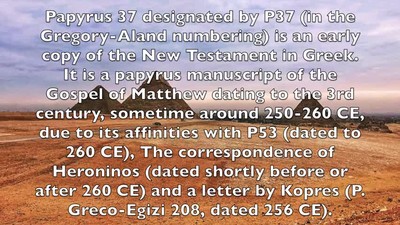Biblical Papyrus Photos
The earliest sources for the Greek New Testament are the papyri in codex (book-like) form. Of course, this designation came from the medium on which they were inscribed. At present, there have been over 139 of these discovered, with eighty of these manuscripts dating between 100 – 300 C.E., with the number increasing 21 more papyri from 290-390 C.E., with a total of 139, dating between 100-500 C.E. These biblical papyri range from a very small fragment to codices, which may be incomplete, but still contain large portions of several New Testament books. They are noted in literature with the Black letter character also known as Gothic script 𝔓, or by an upper- or lowercase “P” followed by a superscript Arabic number. (e.g., 𝔓52, 𝔓66, and 𝔓75).
P52 is the oldest manuscript of the New Testament known today. It measures 21/2 by 31/2 inches and contains only a few verses of the fourth gospel, John 18:31-33 (recto, the front), 37, and 38 (verso, the back). Bernard P. Grenfell acquired it around 1920, yet it went unnoticed until 1934 when paleographer C. E. Roberts took notice of the fact that it contained the Gospel of John. Roberts had evaluated the fragment, dating it to the beginning of the second century C.E. While other paleographers disagreed, other renowned scholars reached the same conclusion, including Frederic Kenyon, W. Schubart, Harold I. Bell, Adolf Deissmann, Ulrich Wilcken, and W. H. P. Hatch. P52 is very important because It establishes that the Gospel of John was written in the first century.
Papyrus 37 designated by P37 (in the Gregory-Aland numbering) is an early copy of the New Testament in Greek. It is a papyrus manuscript of the Gospel of Matthew dating to the 3rd century, sometime around 250-260 CE, due to its affinities with P53 (dated to 260 CE), The correspondence of Heroninos (dated shortly before or after 260 CE) and a letter by Kopres (P. Greco-Egizi 208, dated 256 CE).
The "Magdalen" papyrus was purchased in Luxor, Egypt in 1901 by Reverend Charles Bousfield Huleatt (1863–1908), who identified the Greek fragments as portions of the Gospel of Matthew (Chapter 26:23 and 31) and presented them to Magdalen College, Oxford, where they are cataloged as P. Magdalen Greek 17 (Gregory-Aland P64) and whence they have their name. When the fragments were finally published by Colin H. Roberts in 1953, illustrated with a photograph, the hand was characterized as "an early predecessor of the so-called 'Biblical Uncial'" which began to emerge towards the end of the 2nd century. The uncial style is epitomised by the later biblical Codex Vaticanus and Codex Sinaiticus. Comparative paleographical analysis has remained the methodological key for dating the manuscript, but there is no consensus on the dating of the papyrus. Estimates have ranged from the first century to the fourth century AD.
Papyrus 66 (also referred to as P66) is a near complete codex of the Gospel of John, and part of the collection known as the Bodmer Papyri. The manuscript contains John 1:1–6:11, 6:35b–14:26, 29–30; 15:2–26; 16:2–4, 6–7; 16:10–20:20, 22–23; 20:25–21:9, 12, 17. It is one of the oldest well-preserved New Testament manuscripts known to exist. Its original editor assigned the codex to the early third century, or around AD 200, on the basis of its style of handwriting.
Herbert Hunger later claimed that the handwriting should be dated to an earlier period in the middle or early part of the second century. More recently, Brent Nongbri has produced a broader study of the codex and argued that when one takes into consideration the format, construction techniques, and provenance of the codex along with the handwriting, it is more reasonable to conclude that the codex was produced "in the early or middle part of the fourth century." However, there has been a push to declare any manuscripts that includes John 6:4 to be of the 4th century or later. Refuting Brent Nongbri's astute claim is the works of a seasoned Christian literary scholar, the late Emeritus Professor of New Testament Language, Literature & Theology Larry W. Hurtado.
Papyrus 86 (in the Gregory-Aland numbering), designated by siglum
P86, is an early copy of the New Testament in Greek. It is a papyrus manuscript of the Gospel of Matthew. The manuscript palaeographically has been assigned to the 4th century. The surviving texts of Matthew are verses 5:13-16, 22-25.
P52 is the oldest manuscript of the New Testament known today. It measures 21/2 by 31/2 inches and contains only a few verses of the fourth gospel, John 18:31-33 (recto, the front), 37, and 38 (verso, the back). Bernard P. Grenfell acquired it around 1920, yet it went unnoticed until 1934 when paleographer C. E. Roberts took notice of the fact that it contained the Gospel of John. Roberts had evaluated the fragment, dating it to the beginning of the second century C.E. While other paleographers disagreed, other renowned scholars reached the same conclusion, including Frederic Kenyon, W. Schubart, Harold I. Bell, Adolf Deissmann, Ulrich Wilcken, and W. H. P. Hatch. P52 is very important because It establishes that the Gospel of John was written in the first century.
Papyrus 37 designated by P37 (in the Gregory-Aland numbering) is an early copy of the New Testament in Greek. It is a papyrus manuscript of the Gospel of Matthew dating to the 3rd century, sometime around 250-260 CE, due to its affinities with P53 (dated to 260 CE), The correspondence of Heroninos (dated shortly before or after 260 CE) and a letter by Kopres (P. Greco-Egizi 208, dated 256 CE).
The "Magdalen" papyrus was purchased in Luxor, Egypt in 1901 by Reverend Charles Bousfield Huleatt (1863–1908), who identified the Greek fragments as portions of the Gospel of Matthew (Chapter 26:23 and 31) and presented them to Magdalen College, Oxford, where they are cataloged as P. Magdalen Greek 17 (Gregory-Aland P64) and whence they have their name. When the fragments were finally published by Colin H. Roberts in 1953, illustrated with a photograph, the hand was characterized as "an early predecessor of the so-called 'Biblical Uncial'" which began to emerge towards the end of the 2nd century. The uncial style is epitomised by the later biblical Codex Vaticanus and Codex Sinaiticus. Comparative paleographical analysis has remained the methodological key for dating the manuscript, but there is no consensus on the dating of the papyrus. Estimates have ranged from the first century to the fourth century AD.
Papyrus 66 (also referred to as P66) is a near complete codex of the Gospel of John, and part of the collection known as the Bodmer Papyri. The manuscript contains John 1:1–6:11, 6:35b–14:26, 29–30; 15:2–26; 16:2–4, 6–7; 16:10–20:20, 22–23; 20:25–21:9, 12, 17. It is one of the oldest well-preserved New Testament manuscripts known to exist. Its original editor assigned the codex to the early third century, or around AD 200, on the basis of its style of handwriting.
Herbert Hunger later claimed that the handwriting should be dated to an earlier period in the middle or early part of the second century. More recently, Brent Nongbri has produced a broader study of the codex and argued that when one takes into consideration the format, construction techniques, and provenance of the codex along with the handwriting, it is more reasonable to conclude that the codex was produced "in the early or middle part of the fourth century." However, there has been a push to declare any manuscripts that includes John 6:4 to be of the 4th century or later. Refuting Brent Nongbri's astute claim is the works of a seasoned Christian literary scholar, the late Emeritus Professor of New Testament Language, Literature & Theology Larry W. Hurtado.
Papyrus 86 (in the Gregory-Aland numbering), designated by siglum
P86, is an early copy of the New Testament in Greek. It is a papyrus manuscript of the Gospel of Matthew. The manuscript palaeographically has been assigned to the 4th century. The surviving texts of Matthew are verses 5:13-16, 22-25.
Biblical Papyrus Photos
9
May 27, 2020
02:15
The earliest sources for the Greek New Testament are the papyri in codex (book-like) form. Of course, this designation came from the medium on which they were inscribed. At present, there have been over 139 of these discovered, with eighty of these manuscripts dating between 100 – 300 C.E., with the number increasing 21 more papyri from 290-390 C.E., with a total of 139, dating between 100-500 C.E. These biblical papyri range from a very small fragment to codices, which may be incomplete, but still contain large portions of several New Testament books. They are noted in literature with the Black letter character also known as Gothic script 𝔓, or by an upper- or lowercase “P” followed by a superscript Arabic number. (e.g., 𝔓52, 𝔓66, and 𝔓75).
P52 is the oldest manuscript of the New Testament known today. It measures 21/2 by 31/2 inches and contains only a few verses of the fourth gospel, John 18:31-33 (recto, the front), 37, and 38 (verso, the back). Bernard P. Grenfell acquired it around 1920, yet it went unnoticed until 1934 when paleographer C. E. Roberts took notice of the fact that it contained the Gospel of John. Roberts had evaluated the fragment, dating it to the beginning of the second century C.E. While other paleographers disagreed, other renowned scholars reached the same conclusion, including Frederic Kenyon, W. Schubart, Harold I. Bell, Adolf Deissmann, Ulrich Wilcken, and W. H. P. Hatch. P52 is very important because It establishes that the Gospel of John was written in the first century.
Papyrus 37 designated by P37 (in the Gregory-Aland numbering) is an early copy of the New Testament in Greek. It is a papyrus manuscript of the Gospel of Matthew dating to the 3rd century, sometime around 250-260 CE, due to its affinities with P53 (dated to 260 CE), The correspondence of Heroninos (dated shortly before or after 260 CE) and a letter by Kopres (P. Greco-Egizi 208, dated 256 CE).
The "Magdalen" papyrus was purchased in Luxor, Egypt in 1901 by Reverend Charles Bousfield Huleatt (1863–1908), who identified the Greek fragments as portions of the Gospel of Matthew (Chapter 26:23 and 31) and presented them to Magdalen College, Oxford, where they are cataloged as P. Magdalen Greek 17 (Gregory-Aland P64) and whence they have their name. When the fragments were finally published by Colin H. Roberts in 1953, illustrated with a photograph, the hand was characterized as "an early predecessor of the so-called 'Biblical Uncial'" which began to emerge towards the end of the 2nd century. The uncial style is epitomised by the later biblical Codex Vaticanus and Codex Sinaiticus. Comparative paleographical analysis has remained the methodological key for dating the manuscript, but there is no consensus on the dating of the papyrus. Estimates have ranged from the first century to the fourth century AD.
Papyrus 66 (also referred to as P66) is a near complete codex of the Gospel of John, and part of the collection known as the Bodmer Papyri. The manuscript contains John 1:1–6:11, 6:35b–14:26, 29–30; 15:2–26; 16:2–4, 6–7; 16:10–20:20, 22–23; 20:25–21:9, 12, 17. It is one of the oldest well-preserved New Testament manuscripts known to exist. Its original editor assigned the codex to the early third century, or around AD 200, on the basis of its style of handwriting.
Herbert Hunger later claimed that the handwriting should be dated to an earlier period in the middle or early part of the second century. More recently, Brent Nongbri has produced a broader study of the codex and argued that when one takes into consideration the format, construction techniques, and provenance of the codex along with the handwriting, it is more reasonable to conclude that the codex was produced "in the early or middle part of the fourth century." However, there has been a push to declare any manuscripts that includes John 6:4 to be of the 4th century or later. Refuting Brent Nongbri's astute claim is the works of a seasoned Christian literary scholar, the late Emeritus Professor of New Testament Language, Literature & Theology Larry W. Hurtado.
Papyrus 86 (in the Gregory-Aland numbering), designated by siglum
P86, is an early copy of the New Testament in Greek. It is a papyrus manuscript of the Gospel of Matthew. The manuscript palaeographically has been assigned to the 4th century. The surviving texts of Matthew are verses 5:13-16, 22-25.
P52 is the oldest manuscript of the New Testament known today. It measures 21/2 by 31/2 inches and contains only a few verses of the fourth gospel, John 18:31-33 (recto, the front), 37, and 38 (verso, the back). Bernard P. Grenfell acquired it around 1920, yet it went unnoticed until 1934 when paleographer C. E. Roberts took notice of the fact that it contained the Gospel of John. Roberts had evaluated the fragment, dating it to the beginning of the second century C.E. While other paleographers disagreed, other renowned scholars reached the same conclusion, including Frederic Kenyon, W. Schubart, Harold I. Bell, Adolf Deissmann, Ulrich Wilcken, and W. H. P. Hatch. P52 is very important because It establishes that the Gospel of John was written in the first century.
Papyrus 37 designated by P37 (in the Gregory-Aland numbering) is an early copy of the New Testament in Greek. It is a papyrus manuscript of the Gospel of Matthew dating to the 3rd century, sometime around 250-260 CE, due to its affinities with P53 (dated to 260 CE), The correspondence of Heroninos (dated shortly before or after 260 CE) and a letter by Kopres (P. Greco-Egizi 208, dated 256 CE).
The "Magdalen" papyrus was purchased in Luxor, Egypt in 1901 by Reverend Charles Bousfield Huleatt (1863–1908), who identified the Greek fragments as portions of the Gospel of Matthew (Chapter 26:23 and 31) and presented them to Magdalen College, Oxford, where they are cataloged as P. Magdalen Greek 17 (Gregory-Aland P64) and whence they have their name. When the fragments were finally published by Colin H. Roberts in 1953, illustrated with a photograph, the hand was characterized as "an early predecessor of the so-called 'Biblical Uncial'" which began to emerge towards the end of the 2nd century. The uncial style is epitomised by the later biblical Codex Vaticanus and Codex Sinaiticus. Comparative paleographical analysis has remained the methodological key for dating the manuscript, but there is no consensus on the dating of the papyrus. Estimates have ranged from the first century to the fourth century AD.
Papyrus 66 (also referred to as P66) is a near complete codex of the Gospel of John, and part of the collection known as the Bodmer Papyri. The manuscript contains John 1:1–6:11, 6:35b–14:26, 29–30; 15:2–26; 16:2–4, 6–7; 16:10–20:20, 22–23; 20:25–21:9, 12, 17. It is one of the oldest well-preserved New Testament manuscripts known to exist. Its original editor assigned the codex to the early third century, or around AD 200, on the basis of its style of handwriting.
Herbert Hunger later claimed that the handwriting should be dated to an earlier period in the middle or early part of the second century. More recently, Brent Nongbri has produced a broader study of the codex and argued that when one takes into consideration the format, construction techniques, and provenance of the codex along with the handwriting, it is more reasonable to conclude that the codex was produced "in the early or middle part of the fourth century." However, there has been a push to declare any manuscripts that includes John 6:4 to be of the 4th century or later. Refuting Brent Nongbri's astute claim is the works of a seasoned Christian literary scholar, the late Emeritus Professor of New Testament Language, Literature & Theology Larry W. Hurtado.
Papyrus 86 (in the Gregory-Aland numbering), designated by siglum
P86, is an early copy of the New Testament in Greek. It is a papyrus manuscript of the Gospel of Matthew. The manuscript palaeographically has been assigned to the 4th century. The surviving texts of Matthew are verses 5:13-16, 22-25.
Loading...
There is no content for this section
--- End of Results ---
Today's Devotional
A Prayer to Give Joyfully and Trust God - Your Daily Prayer - July 23
When was the last time you gave without hesitation? This story reminds us that every gift (big or small) can carry eternal impact when placed in God’s hands.







